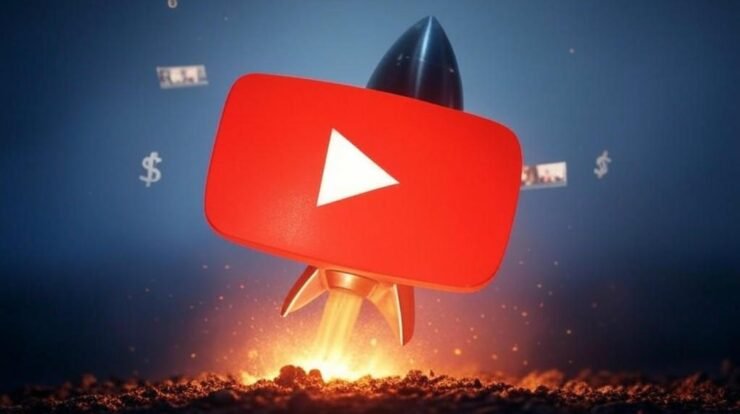YouTube has transformed from a simple video-sharing platform into a thriving ecosystem where creators can turn their passion into profit. If you’ve ever wondered how to earn through YouTube, you’re not alone. Millions of aspiring creators dream of building a sustainable income stream through their channels, but the path to success requires strategy, persistence, and a deep understanding of the platform’s dynamics. As someone who has studied the ins and outs of YouTube monetization and worked with creators to grow their channels, I’m here to share a comprehensive guide to help you navigate this exciting yet challenging journey.
This article will walk you through proven methods to make money on YouTube, from leveraging the YouTube Partner Program to diversifying income streams. Whether you’re a beginner or an experienced creator looking to scale, these insights will provide actionable steps to maximize your earnings while building a loyal audience.
Understanding YouTube’s Monetization Landscape

Before diving into specific strategies, it’s crucial to grasp how YouTube’s monetization system works. At its core, YouTube offers creators multiple ways to earn money, but the most well-known starting point is the YouTube Partner Program (YPP). To qualify for YPP, your channel must meet two key thresholds: 1,000 subscribers and 4,000 public watch hours in the past 12 months. These requirements ensure that only creators with consistent engagement can monetize through ads.
However, relying solely on ad revenue is like putting all your eggs in one basket. Successful YouTubers diversify their income through sponsorships, affiliate marketing, merchandise, memberships, and more. The key is to create high-quality content that resonates with your audience while strategically integrating these revenue streams. Let’s break down each method and explore how to implement them effectively.
Step 1: Build a Strong Foundation with Quality Content
The cornerstone of earning through YouTube is creating content that people want to watch. Without compelling videos, no monetization strategy will work. Here’s how to set yourself up for success:
Identify Your Niche
Your niche is the heart of your channel. It’s what sets you apart in a crowded platform with millions of creators. Whether it’s tech reviews, cooking tutorials, travel vlogs, or gaming walkthroughs, your niche should align with your expertise and passion. Ask yourself: What unique value can I offer? Research trending topics within your niche using tools like Google Trends or TubeBuddy to ensure there’s audience demand.
Invest in Production Quality
You don’t need a Hollywood budget, but basic equipment like a decent microphone, camera, and editing software can make a big difference. Clear audio and visuals keep viewers engaged, reducing bounce rates and increasing watch time—a critical factor for YouTube’s algorithm. Free editing tools like DaVinci Resolve or CapCut are great starting points for beginners.
Optimize for Search
To attract organic traffic, optimize your videos for search. Use descriptive titles, compelling thumbnails, and detailed descriptions that include keywords like how to earn through YouTube, YouTube monetization tips, or make money on YouTube. For example, a title like “5 Proven Ways to Make Money on YouTube in 2025” is specific, clickable, and keyword-rich. Include relevant tags and create playlists to keep viewers on your channel longer.
Engage Your Audience
YouTube’s algorithm favors videos with high engagement. Encourage viewers to like, comment, and subscribe. Ask questions in your videos to spark discussion, and respond to comments to build a community. Engaged viewers are more likely to watch your content consistently, helping you meet YPP requirements faster.
Read more: Top 10 Websites That Pay Real Money – Your Ultimate Guide to Earning Online
Step 2: Unlock Ad Revenue Through the YouTube Partner Program
Once you hit 1,000 subscribers and 4,000 watch hours, you can apply for the YouTube Partner Program. Ad revenue is often the first monetization method creators explore, but it’s not a get-rich-quick scheme. Here’s how to make the most of it:
Understand CPM and RPM
CPM (cost per mille) is the amount advertisers pay per 1,000 ad impressions. RPM (revenue per mille) is what you earn after YouTube takes its 45% cut. CPM varies by niche—finance and tech channels often earn higher CPMs ($10-$20) than lifestyle or gaming ($2-$5). To boost ad revenue, focus on creating content in high-CPM niches and producing longer videos (8-10 minutes) to include multiple ad breaks.
Optimize Ad Placement
YouTube allows you to choose where ads appear in your videos. Mid-roll ads (placed during the video) can increase revenue, but don’t overdo it—too many ads can frustrate viewers. Aim for a balance that maximizes earnings without compromising viewer experience. Analyze your audience retention reports in YouTube Studio to identify where viewers drop off and adjust ad placement accordingly.
Create Evergreen Content
Evergreen videos—content that remains relevant over time—can generate ad revenue for years. Tutorials, how-to guides, and product reviews are excellent examples. For instance, a video titled “How to Start a YouTube Channel and Earn Money in 2025” can attract views long after it’s published, providing a steady income stream.
Step 3: Diversify Your Income Streams
While ad revenue is a solid starting point, relying on it alone limits your earning potential. Here are additional ways to make money on YouTube:
Sponsorships and Brand Deals
Sponsorships are a lucrative way to earn, especially for creators with engaged audiences. Brands pay you to promote their products or services in your videos. To attract sponsors, create a media kit showcasing your channel’s stats, audience demographics, and niche expertise. Platforms like FameBit or Grapevine connect creators with brands, but you can also reach out directly to companies in your niche.
Pro tip: Only partner with brands that align with your values and audience. Authenticity builds trust, which is critical for long-term success. For example, a fitness channel might partner with a sports nutrition brand, while a tech channel could collaborate with a gadget company.
Affiliate Marketing
Affiliate marketing involves promoting products and earning a commission for each sale made through your unique links. Amazon’s Affiliate Program is a popular choice, but you can also join networks like ShareASale or ClickBank. Embed affiliate links in your video descriptions and mention them naturally in your content. For example, a video about “How to Earn Through YouTube” could include affiliate links to microphones or editing software.
To maximize affiliate earnings, create product reviews or tutorials that showcase the value of the products you’re promoting. Transparency is key—disclose that you’re using affiliate links to maintain trust with your audience.
Sell Your Own Products or Services
Once you’ve built a loyal audience, consider selling your own merchandise, courses, or services. Platforms like Teespring or Spreadshop make it easy to create branded merchandise like t-shirts or mugs. If you’re an expert in your niche, you could develop an online course or offer consulting services. For example, a photography channel might sell presets or offer one-on-one coaching.
Channel Memberships and Super Chats
If you have a dedicated fanbase, channel memberships can provide recurring revenue. For a monthly fee, subscribers get exclusive perks like badges, emojis, or members-only content. To enable memberships, you need to be in the YPP and have at least 1,000 subscribers (in some regions, 30,000 subscribers).
Super Chats and Super Stickers are another way to earn during live streams. Viewers can pay to highlight their messages, providing a direct way to support your channel. Host regular live streams or Q&A sessions to encourage these contributions.
Crowdfunding
Platforms like Patreon or Buy Me a Coffee allow fans to support your work through one-time or recurring donations. Offer exclusive content, behind-the-scenes access, or personalized shoutouts to incentivize contributions. Crowdfunding works best for creators with highly engaged, niche audiences.
Read more: Unlocking the Secrets of Online Task Earning – A Blogger’s Journey
Step 4: Scale Your Channel for Long-Term Growth
Earning through YouTube isn’t just about hitting monetization milestones—it’s about building a sustainable business. Here’s how to scale your channel:
Analyze and Adapt
YouTube Studio provides detailed analytics on watch time, audience retention, and traffic sources. Use these insights to identify what’s working and what isn’t. For example, if a particular video format drives high engagement, create more content in that style. Experiment with different thumbnails, titles, and video lengths to optimize performance.
Collaborate with Other Creators
Collaborations expose your channel to new audiences. Partner with creators in your niche or complementary niches for guest appearances, joint videos, or shoutouts. For example, a travel vlogger might collaborate with a food vlogger to create a video about local cuisine. Reach out via email or social media with a clear pitch outlining the mutual benefits.
Stay Consistent
Consistency is key to growing your channel and earnings. Develop a content schedule—whether it’s one video per week or three—and stick to it. Use tools like Trello or Notion to plan your content calendar and ensure you’re covering topics that align with your audience’s interests.
Stay Updated on YouTube Policies
YouTube’s policies and algorithms evolve constantly. Stay informed about changes to monetization rules, community guidelines, and algorithm updates. Join creator communities on platforms like Reddit or Discord to share tips and stay ahead of the curve.
Common Pitfalls to Avoid
As you work toward earning through YouTube, steer clear of these mistakes:
- Chasing Trends Blindly: While trending topics can boost views, creating content solely for trends can alienate your core audience. Balance trendy videos with evergreen content.
- Ignoring SEO: Without proper optimization, your videos may not reach their full potential. Always research keywords and optimize your metadata.
- Overloading Ads: Too many ads can drive viewers away. Prioritize viewer experience to maintain retention.
- Neglecting Audience Engagement: Failing to interact with your audience can stunt your channel’s growth. Respond to comments and create content that sparks conversation.
Read more: Earn Money Online Without Investment by Typing: A Personal Journey to Financial Freedom
The Mindset of a Successful YouTube Creator

Earning through YouTube requires more than just technical know-how—it demands the right mindset. Treat your channel like a business, but don’t lose sight of your passion. Success doesn’t happen overnight; it’s the result of consistent effort, learning from failures, and adapting to feedback. Celebrate small wins, like hitting 100 subscribers or earning your first $10, and use them as motivation to keep going.
Surround yourself with a supportive community, whether it’s other creators, mentors, or your audience. Their feedback and encouragement will fuel your growth. Most importantly, stay authentic. Your unique voice and perspective are what will make your channel stand out in a sea of content.
Conclusion: Your Path to YouTube Success
Earning through YouTube is an achievable goal, but it requires strategy, dedication, and adaptability. By creating high-quality content, optimizing for search, and diversifying your income streams, you can turn your channel into a sustainable source of income. Whether you’re aiming for a side hustle or a full-time career, the key is to start small, learn from data, and scale strategically.
Take the first step today: pick a niche, create your first video, and commit to improving with every upload. With persistence and the right approach, you’ll not only earn through YouTube but also build a platform that inspires and connects with audiences worldwide.






